As we’ve reported, thanks to space-saving, small-supply oxygen systems from Aerox and Aithre, more pilots and their passengers may be using O2 in the cabin who otherwise wouldn’t. But we’re also hearing about the challenges of getting these little cylinders filled.
Some FBOs and maintenance shops unfamiliar with these new bottles (some as small as 47 liters) are reluctant to fill them. After being turned away with one of our Aithre demo cylinders, we did some digging and found there’s more to filling and maintaining tanks than we thought. That includes regulations and the accompanying nomenclature that’s stamped on the hardware. There’s also upkeep, including testing.
No FAA Regs
Traditionally, the oxygen cylinders used in GA applications (and for other markets, too) are regulated by the Department of Transportation (DOT) under Title 49 CFR Part 180. This regulation, which deals with hazardous materials, has a broad scope covering pressure containers. As it relates to breathing oxygen, the regs prescribe specific requirements pertaining to the maintenance, reconditioning, repair, inspection and testing of its “packaging,” and any other function having an effect on the continuing qualification and use of its packaging. Get that? We had to read it a few times, too. Typical government verbiage, yes, but a governing oversight that’s arguably necessary since we store and transport in our cabins—usually not gently—high-pressure oxygen cylinders packing over 2200 PSI. DOT certification is also the green light for shipping cylinders containing oxygen.
In the world of portable aviator’s oxygen tanks, the DOT regulations govern not specifically the transportation of oxygen-filled cylinders, but things like hydrostatic testing, cylinder life limits and even the specific nomenclature marked on the cylinders—which is what refilling stations have been trained to look for before refilling them. To reiterate, portable cylinders are not governed at all by the FAA. But FAA repair stations and A&Ps still answer to the DOT when refilling them.
Several mechanics (FBOs generally farm out tank refills to A&P mechanics) told us the first thing they look for is the data on the tank, including the marking that it’s a DOT-approved cylinder, the cylinder’s classification, its service pressure, serial number and the date code representing the original date of manufacturing. Perhaps most important, refillers are looking for the stamp on the cylinder that shows the date of the next hydrostatic test. Dumbed down, it’s kind of like bringing your propane tank to be filled, only more stringent.
Life Limits, Testing
Regardless of the cylinder’s construction, most of the DOT certification requirements are the same, with some exceptions mostly related to life limits. We asked Florida-based Aerox for a rundown on the process for maintaining its DOT-approved cylinders, and it was clear that the company doesn’t take the certification lightly—knowing the ins and out of the DOT spec—and clearly labels and stamps its cylinders accordingly. Know what you have, and what’s required.
The aluminum cylinders have no life limitations as long as they pass the hydrostatic test every five years. That’s why you’ll see the next-due test date stamped on a metal tag front and center on the cylinder. The Kevlar cylinders, which have a rigidly laminated fabric over an aluminum shell construction, are continuously expanding and contracting, naturally stressing the cylinder over time, Aerox explained. As result, there’s a 15-year life limit on each Kevlar cylinder for as long as they pass a hydrostatic test every five years. Thin-wall steel cylinders have a 24-year life limit with a three-year hydrostatic test cycle and the thick-wall steel cylinders have an unlimited life cycle as long as they pass their five-year hydro. Most cylinders successfully pass the test, but some do flunk.
Aerox says one way to preserve the tank is to avoid contamination—including the condensation that can form in a cylinder that’s improperly stored while it’s empty. Use so-called clean oxygen (most of the breathing oxygen you’ll get these days is pure).
We’re told that finding a source for hydrostatic testing should be easy, and any facility that can test a fire extinguisher bottle can handle an oxygen cylinder. During testing, the cylinder is inserted into a water-filled test chamber where it’s pressurized to measure the displacement of the water to a given specification, depending on the cylinder’s construction (aluminum or Kevlar). Worth mentioning is that you can still continue to use a cylinder that’s out of its test-by date, but it must be hydrostatic tested before its next refilling.
Testing aside, Aerox said its cylinders go through an extensive cleaning in a cleanroom using an FAA-approved cleaning solution. As part of the process, its cylinders maintain a small (less than 20 PSI) positive pressure to make sure no contaminants enter the cylinder during handling and transport.
“For us, not having DOT oversight would be a non-starter,” Aerox’s Scott Ashton told us. Worth mentioning is that Aerox is an FAA repair station.
Aithre’s Carbon Fiber Cylinders
We like the slim design of the smaller composite cylinders that Idaho-based Aithre sells (not manufactures on its own). They’re easy to stash in a map pocket or flight bag, or even a backpack for extreme outdoor sports.
These bottles don’t have DOT certification, but instead have a CE mark. This is a European specification indicating that the product has been deemed by its manufacturer to meet safety, health and environmental protection requirements.
On its website, Aithre posts the CE certificate for its bottles, along with a bottle inspection and testing report. This “batch inspection certificate of quality report” shows data like cylinder burst pressure, nominal working pressure and normal bottle spec, plus a statement that the product is “proved to be qualified after testing and inspection in accordance with ISO 11119-3, composite cylinders for breathing apparatus.”
We asked Aithre’s Jim Ruttler about the quality control of the cylinders, which are supplied to Aithre by a CE-approved manufacturer.
“We are attracted to the CE bottles because of their superior characteristics, size and price, along with the stringent ISO testing standards that come with the CE certification,” he told us. Ruttler pointed out that the DOT regs don’t apply to private noncommercial use, but to the transportation of goods by carriers in commerce—UPS and FedEx, as examples. Aithre ships empty tanks.
“This is the same reason that private pilots can fly around with 100LL in their fuel tanks without DOT oversight—they are using the fuel to get places—not transporting the fuel as a carrier,” Ruttler told us.
On the other hand, it can be argued that an aircraft fuel tank is subject to continued airworthiness requirements. On its website, Aithre has a link for the bottle’s five-year hydrostatic testing and it links to Hogans Alley Paintball in Meriden, Connecticut, which charges $28.50 for fiber-wrapped bottles with an approximate one-week turnaround. The cylinders have a 15-year life limit. Worth mentioning is that the tech who refilled our demo Aithre cylinder pointed out that there wasn’t a DOT marking on it, but he filled it anyway. He did ask about a visibly missing safety relief valve, in case he accidentally overfilled it.
Ruttler told us that Aithre’s recently introduced adjustable flow regulators that are currently being used on the AVI8 smart pulse system do indeed have a reseating safety relief valve built in, with an operating range to 3000 PSI. These regulators have the built-in refilling port, dual output ports (with one having adjustable fixed flow from 0-25 LPM), plus a safety shroud to protect against damage from dropping. There is also an all-in-one combined valve and adjustable regulator. These regulators are made for Aithre by an FDA medical device manufacture and have an ISO certificate. We looked at this system—with favorable results—in a field report in the October 2021 issue of Aviation Consumer.
Ruttler said the composite bottles Aithre sells have burst pressures of over 16,000 PSI and working pressures of over 4300 PSI, so they are safe to fill at the normal low 2000 PSI range levels.
Roll Your Own Filling Station
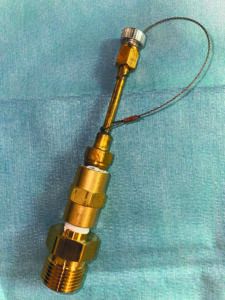
Regardless of your comfort factor based on a cylinder’s certification status, you can avoid the hassles of finding a source for refilling whatever you choose by sourcing your own refilling tanks and supply of oxygen. Got a last-minute trip but the refilling shop is closed? There is convenience in having your own supply. Of course, you’ll have to source your own gas supplier to have the supply cylinders refilled.
Aerox told us it’s selling more transfill systems than ever as pilots struggle to find tank refillers when they need them—a trend we’re hearing about, which ultimately can hinder the use of oxygen. Its most basic transfill station consists of two standard tanks with CGA-540 connections, a slow-fill restrictor and six feet of braided stainless filler line to connect directly to an Aerox portable cylinder. If you do a lot of refilling, you can add as many supply cylinders as you want, with some options to include an overfill regulator and a bleeder device for bleeding off the pressure before disconnecting the supply line. Keep in mind that most of the supply cylinders are around 2300 PSI, while portable cylinders may be lower. We like the ability to set the outflow pressure as a safety backstop. Overfill a cylinder and you can rupture the safety burst disc—a pricey mistake. All Aerox cylinders are equipped with safety burst discs.
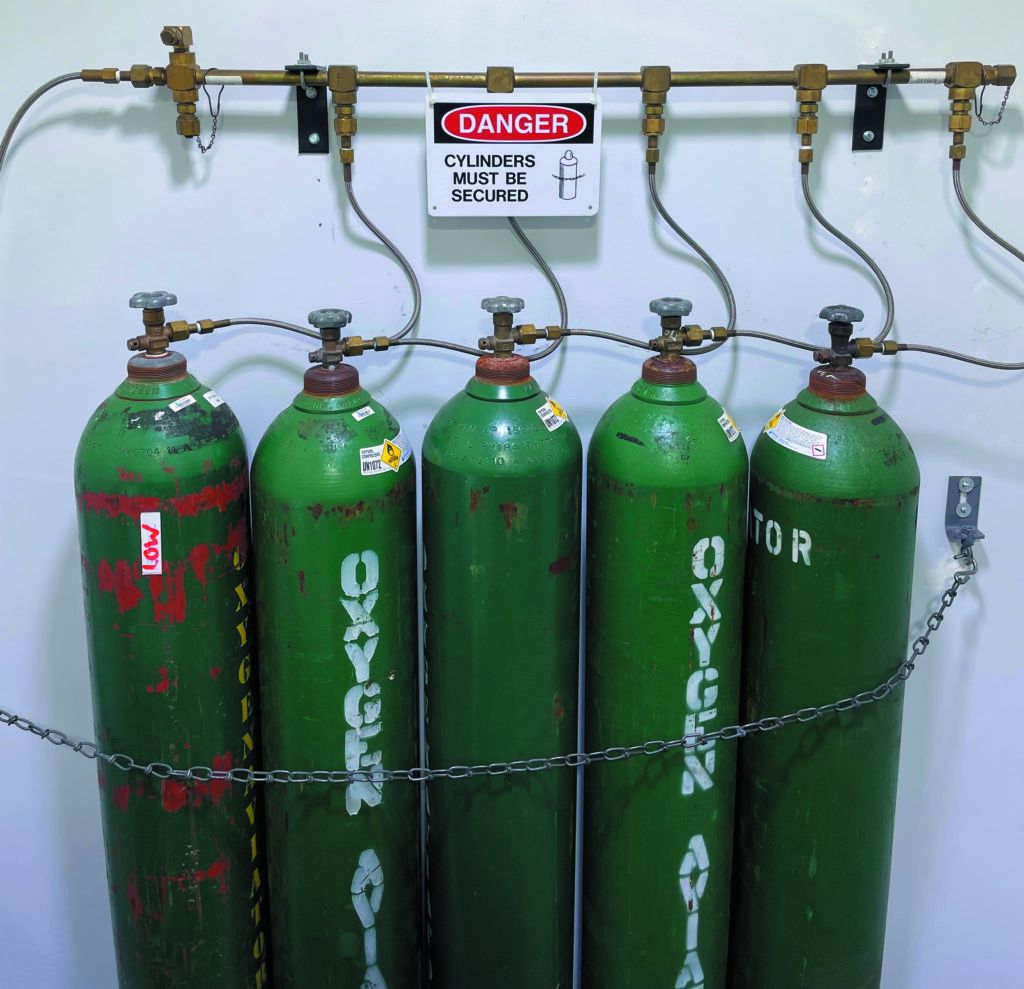
An Aerox two-cylinder cascade starts at $489 and goes up to $1489 with five cylinders, a control regulator and bleed valve. The Aerox bottles use a standard CGA-540 fitting, or a PB-3 fitting for some variations. The PB-3 is a standard for installed systems and the CGA-540 is a standard for portable bottles. Aerox also sells the $360 FBO-1 filling station, which has two CGA-540 cylinder connectors, six feet of braided line, a gauge, flow restrictor and adapters to fit Puritan-Bennett, Scott and of course the standard CGA-540 filler ports.
Aithre sells a 24-inch high-pressure transfill adapter line for its smaller composite cylinders, when the Mountain High regulator isn’t being used.
Last, while filling your own cylinders, remember that you’re dealing with high-pressure O2, so wear proper protection and use clean segregated tools. Fill slowly—200 PSI per minute should be the max flow rate. You’ll see that the compression creates a lot of heat, and filling too fast increases the risk for ignition. Safety first.
Reading The Labels
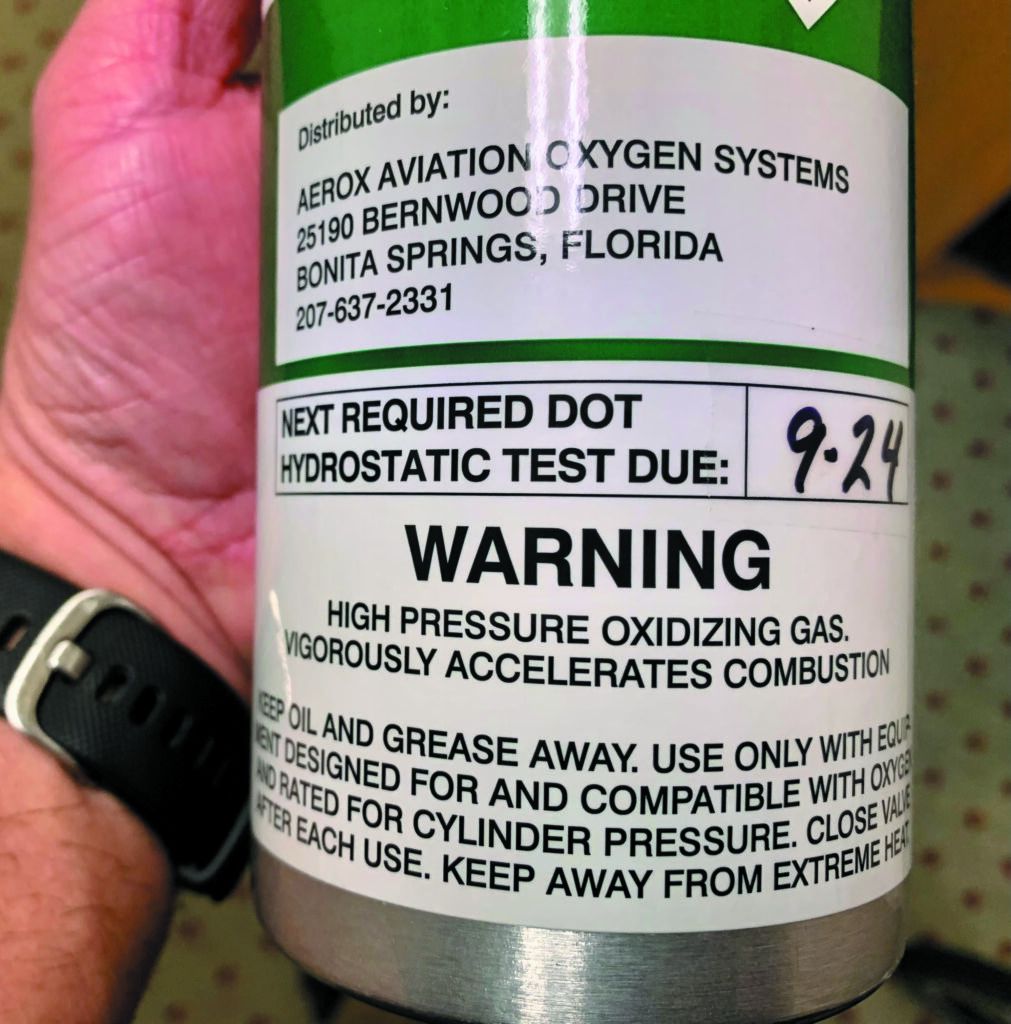
That’s an Aerox PrO2-Plus Flightbag Portable aluminum cylinder above. With DOT approval, it has the hydrostatic testing due date clearly displayed. The Aithre 47-liter composite carbon fiber bottle, below, has CE approval and a manufacturing date and serial number tag.
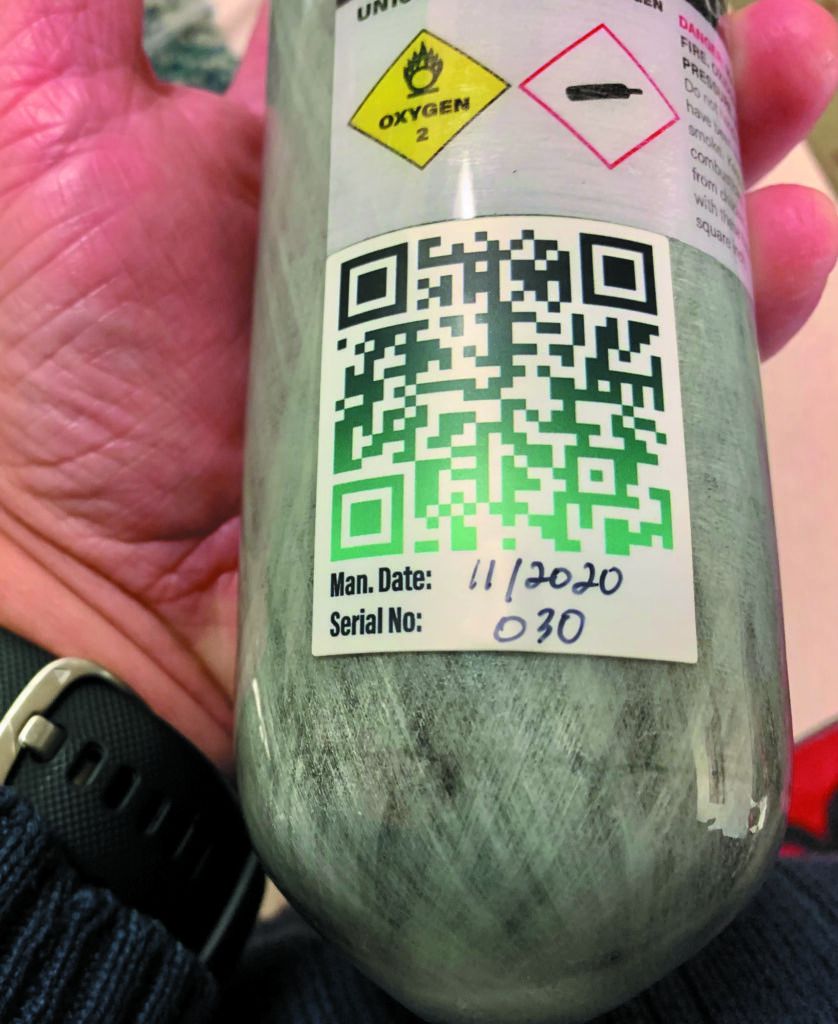
This article originally appeared in the January 2022 issue of Aviation Consumer magazine.
For more great content like this, subscribe to Aviation Consumer!


































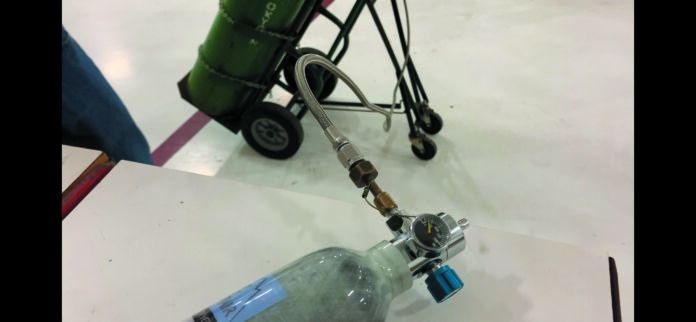

If you don’t know what you’re doing, don’t do it with O2.
Guessing your local airport management may not be as enthusiastic on in-hangar O2 refill infrastructure during annual fire inspections.
Not asking for more FAA help, but for a single string safety of flight item (e.g. pilot’s unnoticed loss of O2 supply above 20’k) when using to prevent hypoxia, the various Rube Goldberg apparatuses relying on vinyl tubing and press on fittings stands in contrast to just about every other safety of flight item’s plumbing/fitting security on an aircraft…and portable adds to the risk of things getting bumped around (lines, regs, etc) during handling, pax/pilot repositioning or turbulence if not carefully stowed/secured.
Thank you Larry – what a wonderfully informative article. I look forward to reading the same type of in-depth reporting on the next level of general aviation oxygen systems, portable oxygen concentrators.